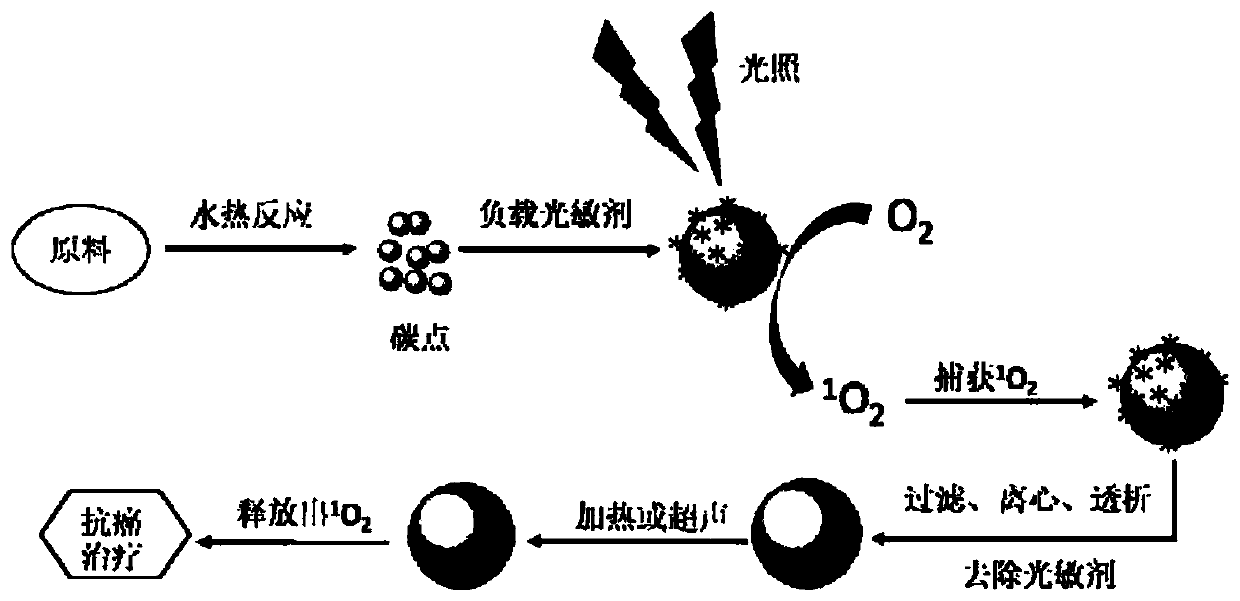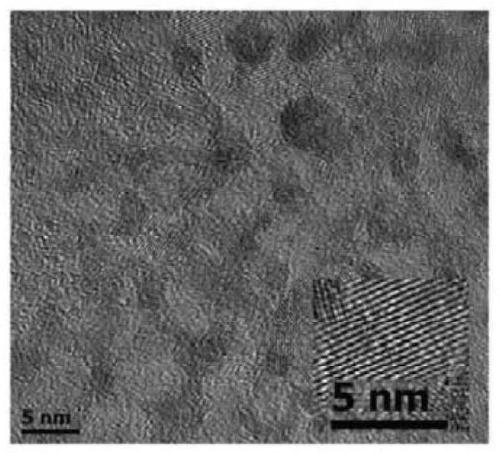Single oxygen controlled-release carbon quantum dots and preparation method and application thereof
A technology of carbon quantum dots and singlet oxygen, which is applied in the field of singlet oxygen controlled-release carbon quantum dots and its preparation, achieving the effects of simple and easy preparation methods, good biocompatibility, and improved encapsulation efficiency
- Summary
- Abstract
- Description
- Claims
- Application Information
AI Technical Summary
Problems solved by technology
Method used
Image
Examples
Embodiment 1
[0037] Select straw as the carbon source to implement the experiment, including the following steps:
[0038] Step 1, preparation of CDs: Put the crushed dry straw into a hydrothermal reaction kettle, add 40mL of water, and heat at 180°C for 12h. After cooling to room temperature, the filtrate was filtered, centrifuged at 16000 rpm for 15 min, and finally dialyzed with ultrapure water to obtain pure CDs aqueous solution.
[0039] Step 2, mixing CDs with a photosensitizer: Add 40ml of the prepared CDs aqueous solution and 1ml of the photosensitizer rose bengal solution into a round bottom flask at room temperature, and stir the mixture at room temperature for 0.5h.
[0040] Step 3, detection of CDs captured 1 o 2 Ability: Divide 40mL prepared mixture of CDs and photosensitizer into 8 equal parts, each group undergoes different light time: 0, 10min, 20min, 30min, 1h, 1.5h, 2h, 2.5h. Then the solutions of each group after illumination were removed by filtration, centrifugation...
Embodiment 2
[0047] Select seaweed as the carbon source to implement the experiment, including the following steps:
[0048] Step 1, preparation of CDs: Put the pulverized dry seaweed into a hydrothermal reaction kettle, add 40mL of water, and heat at 180°C for 12h. After cooling to room temperature, the filtrate was filtered, centrifuged at 16000 rpm for 15 min, and finally dialyzed with ultrapure water to obtain pure CDs aqueous solution.
[0049] Step 2, mixing CDs with a photosensitizer: Add 40ml of the prepared CDs aqueous solution and 1ml of the photosensitizer rose bengal solution into a round bottom flask at room temperature, and stir the mixture at room temperature for 0.5h.
[0050] Step 3, detection of CDs captured 1 o 2 Ability: Divide 40mL prepared CDs and photosensitizer mixture evenly into 8 equal parts, each group undergoes different light time: 0, 10min, 20min, 30min, 1h, 1.5h, 2h, 2.5h. Then the solutions of each group after illumination were removed by filtration, cen...
Embodiment 3
[0057] Select banana peel as the carbon source to implement the experiment, including the following steps:
[0058] Step 1, preparation of CDs: grind dried banana peels, put a certain amount into a hydrothermal reaction kettle, add 40mL of water, and heat at 180°C for 12h. After cooling to room temperature, the filtrate was filtered, centrifuged at 16000 rpm for 15 min, and finally dialyzed with ultrapure water to obtain pure CDs aqueous solution.
[0059] Step 2, mixing CDs with a photosensitizer: Add 40ml of the prepared CDs aqueous solution and 1ml of the photosensitizer rose bengal solution into a round bottom flask at room temperature, and stir the mixture at room temperature for 0.5h.
[0060] Step 3, detection of CDs captured 1 o 2 Ability: Divide 40mL prepared CDs and photosensitizer mixture evenly into 8 equal parts, each group undergoes different light time: 0, 10min, 20min, 30min, 1h, 1.5h, 2h, 2.5h. Then the solutions of each group after illumination were remove...
PUM
 Login to View More
Login to View More Abstract
Description
Claims
Application Information
 Login to View More
Login to View More - R&D
- Intellectual Property
- Life Sciences
- Materials
- Tech Scout
- Unparalleled Data Quality
- Higher Quality Content
- 60% Fewer Hallucinations
Browse by: Latest US Patents, China's latest patents, Technical Efficacy Thesaurus, Application Domain, Technology Topic, Popular Technical Reports.
© 2025 PatSnap. All rights reserved.Legal|Privacy policy|Modern Slavery Act Transparency Statement|Sitemap|About US| Contact US: help@patsnap.com



